
GENZ BENZ - Model 250/500 Bass Amplifier (Page 1, Rev: 1/14/2006)
GENZ BENZ ENCLOSURES
250/500 BASS AMPLIFIER
OWNERS MANUAL
(Rev: 1/14/2006)

GENZ BENZ - Model 250/500 Bass Amplifier (Page 2, Rev: 1/14/2006)
Design Philosophy -
With experience designing and manufacturing both bass guitar speaker cabinets and amplifiers, it
became obvious that there is a large market for a bass amplifier that reproduces the natural tones
of the instrument itself. With many amplifier manufacturers hyping their “distinctive” sound, it seems
forgotten that the player has chosen his instrument for it’s feel, playability and tone. Why then,
should the amplifier manufacturer feel compelled to change this sound?
As with our speakers, Genz Benz amplifiers strive to maximize your instrument’s natural tone and
feeling without imparting additional coloration. This resulting sound will not become obsolete with
changing fads but will always be true to your instrument’s natural qualities.
The circuit design, features, physical construction and speaker selection have been carefully
calculated to give you, the experienced player, the best performance and value in bass guitar
amplification. Featuring sturdy jacks and controls, blendable Tube-Fet front end, a balanced direct
output and an industrial duty bipolar power amplifier with toroidal power transformer, the Genz
Benz 250/500 series bass amplifiers and combos will give you the tools necessary to sound your
very best on stage.
Technical Stuff -
The first stage of the 250/500 preamp uses a low noise bi-fet linear scaling amplifier with a low cut
point at 23 Hz to prevent excessive speaker cone excursion and intermodulation distortion. There
is a smooth first order high pass boost network starting at approx. 2.5kHz with a passband gain
limit of 6 dB. Additional bandwidth roll-off is provided at 20 kHz for RFI suppression. The variable
gain stages are a feedback-divider type control, one of which is all solid state and the other utilizing
a cathode follower (tube) each providing a maximum gain of about 30 dB. On the tube stage,
variable non-linear loading creates a smooth and natural sounding overdrive rich in second
harmonics. These blendable gain stages feed the 4 band active equalizer which is composed of 4
discrete bandpass filters combined in a current summing arrangement. These filters provide 9 dB
of boost and cut, with center position flat. The output amplifier feeds the master volume control and
fully protected power amplifier. A low noise differential output amplifier is provided for the direct
output (switchable pre/post eq) and is phantom power protected.
The power section consists of a low distortion bipolar power amplifier with integrated limiter which
allows gradual overload without sudden loss of feedback control of the speakers. In the model
250, output is rated at 175 watts RMS at 8 ohms and 250 watts RMS at 4 ohms. In the model 500,
output is rated at 275 watts RMS at 8 ohms, 400 watts RMS at 4 ohms and 525 watts RMS at 2
ohms. The amplifier topology is low feedback class A-B with servo control of bias and DC offset.
Also provided is on board output limiting, dual slope integrated VI limiting, solid state thermal
protection, short circuit load protection, dc fault protection and RFI suppression. All amplifier status
points are indicated on a dual color led array.. This amplifier uses heavy duty copper based polar
power transistors directly mounted to a hefty extruded aluminum heatsink. The output section
sports a combined rating of 1600 watts and 128 amps to insure a conservative and reliable design.
An important and not commonly discussed specification is the power amplifier’s ability to deliver
rated power into a reactive load. All speakers present a reactive load to the amplifier which
reduces real world driving ability. The power sections of all model 250 and 500 amplifiers are
rated to deliver full power into a reactive load with a 45 degree (leading or lagging) power factor
phase angle. This is one reason Genz Benz amplifiers sound so big.
Features -
The following feature set is included on all 250/500 Bass Amplifiers. These features were
included based on usability and are the result of the input of veteran players around the country. It
is important for an amplifier to reflect the real needs of the players using them. We feel that this
amplifier series does just that.

GENZ BENZ - Model 250/500 Bass Amplifier (Page 3, Rev: 1/14/2006)

GENZ BENZ - Model 250/500 Bass Amplifier (Page 4, Rev: 1/14/2006)
Inputs -
Two inputs are provided, passive and active.
The passive input has a higher gain and input impedance which is tailored to the characteristics of
passive pickups. 2 distinct types of passive pickup exist (there are some exceptions which aren’t
important for this discussion). A passive magnetic pickup consists basically of a permanent magnet
(or one for each string), called a pole piece, with a wound wire coil around it. As the string
interrupts the magnetic field, the coil picks up the changes, or disturbances, in the magnetic field
and translates these changes into a small electrical signal. (This is the same principal as the large
electrical generator used by your utility company to power your rig on stage!) In order to develop a
strong enough signal to drive an amplifier, the number of windings on the coil(s) must be very
large. Additionally, in order to keep the efficiency of the pickup high, the dimensions of the wire coil
must be small and the magnet flux density kept very high, thus, a small diameter wire is used. The
end result is a signal that has significant output impedance due to the size and length of the wire
used in the pickup’s windings. A passive piezo-ceramic or piezo-film pickup is made of a piezo-
ceramic crystal (or distorted Kynar film). When this material is moved by the vibration of
instrument’s body, the resulting strain on the crystal or film is converted to voltage via the “piezo-
electric effect”. The output impedance of a piezo type pickup is typically higher than the magnetic
pickup. The input impedance of the amplifier’s passive input is set high enough to prevent
interaction with the high output impedance of all commonly used passive pickups, including
magnetic, piezo-ceramic and piezo film types.
The active input has a lower gain and input impedance which is tailored to active pickups. An
active pickup is, for all practical discussions, any pickup that uses preamplification between the
pickup element and the amplifier input. The purpose of this preamplifier is to buffer the high
impedance signal from the pickup element (magnetic, piezo-ceramic, piezo-film etc) and convert it
to a higher level, lower impedance form. It is common for a bass with active pickups to have higher
output level and longer sustain because only a small portion of the energy required to make the
electrical signal comes from the vibrating string. The majority of the energy comes from an external
power source such as a battery. Additional features may be provided with the active pickup, such
as equalization, volume control and compression.
Input Signal Mute Switch -
The inputs on all 250/500 bass amplifiers include an input mute switch. With this switch, you can
place the amplifier (and the direct output) in standby mode between sets without having to change
any of your volume settings. This feature is especially handy during the set when using the tuner
output since you will still be able to use your tuner without having sound come from the amplifier or
P.A. system. No more re-patching or fumbling in the dark! A red LED turns on when the input mute
is active, reminding you that you are in “stand-by” mode.
Input Gain Controls -
The input gain controls, in conjunction with the signal and clip LEDs, allow you to adjust the
preamp input gain sensitivities to the instrument you are playing. Basses can have an output level
from a few thousandths of a volt to several volts. Generally, you want to see the green signal LED
on while you are playing with an occasional flash of the red clip LED when you really hit the string
hard, then adjust the master volume control for playing volume. Distortion of the preamp gain stage
will occur when the red clip LED is illuminated, so plan accordingly. The best signal to noise ratio
will result with the above method. Setting your playing volume will be a combination of the input
gain control and master volume control, depending in part on individual preference. The fet and
tube preamps are fully blendable.

GENZ BENZ - Model 250/500 Bass Amplifier (Page 5, Rev: 1/14/2006)
Tube Dynamics Controls -
The harmonics and saturation controls, in conjunction with the tube gain control, allow additional
control of preamp overdrive variables. The saturation control affects primarily the apex of the
waveform, similar to the effect of overdriving and saturating the output or interstage transformer of a
tube amplifier. Our implementation generates a distortion rich in second harmonics and subtle
waveform compression. The harmonic control affects the waveform closer to the zero crossing
portion of the waveform, yielding a more distinct overdrive with added higher order harmonics and a
steeper signal compression factor. It is important to note that these controls are not an “in your face”
distortion but a creative tool to sculpt the overdrive characteristics of your system.
Signal and Clip LED -
The green signal LED turns on when the preamp gain is set in the optimum gain range. With the
wide output levels of today’s bass guitars, this level allows the signal processing circuits of the
preamp to work within predictable and defined limits to give the best combination of dynamic range
and noise. This indicator samples post equalization signal to accurately reflect preamp system
operating level.
The red clip LED turns on when available headroom in the preamp and equalization gain stages is
less than 6 dB. The indicator samples post equalization signal to accurately reflect preamp system
headroom. Generally, it is best to operate below this level to avoid overloading the preamp and
signal processing circuits.
Active 4 Band Equalization -
The active 4 band equalization used in the model 250/500 amplifiers is composed of 4
independently tuned asymmetrical bandpass filters, combined through a unique current summing
network to create a smooth, musical sounding equalization system.
Low Frequency - 80 Hz
Low-Mid Frequency - 500 Hz
High-Mid Frequency - 1000 Hz
High Frequency - 4000 Hz
Tuner Output Jack -
The tuner output jack is provided to allow a tuner to remain plugged into the amplifier while playing.
This output remains active when the mute switch is pressed, allowing for tuning your instrument
while not sending signal to either the direct output or the speaker. Signal level of -30dB (typical hot
bass level) will drive virtually all commercial tuners.
Effects Insert Jacks -
The effects insert jacks are provided to allow access to the signal for the purpose of inserting
signal processing equipment such as compressors, chorus, delay & reverb processors. Send
(output) and return (input) are nominal -10 dB level. “Series” devices (such as compressors and
gates) require that the signal flow out from the send jack on the amplifier, through the processing
device and back into the return jack on the amplifier. Parallel or mixed signal devices (such as
chorus, delay and reverb processors) require that the signal flow out of the send jack on the
amplifier, through the unit where it is split into a dry (unaltered) signal and a wet (processed)

GENZ BENZ - Model 250/500 Bass Amplifier (Page 6, Rev: 1/14/2006)
signal. On the processing unit, you will use the mixed signal output to return the signals (both wet
and dry) to the return jack on the amplifier. The ratio between the wet signal and the dry signal is
heard as the amount of effects added back to the original signal which is controlled by the mix
knob (also called “balance”) on the effects processor. This may be a real knob (as in the Alesis
Microverb), or software controlled (as in the Yamaha SPX-90, SPX900 or SPX 990).Set the input
sensitivity on the effects processor according to the processor manufacturer’s instructions.
The effects send jack may also be used as an auxiliary output to drive a direct box, tape deck etc.
This output is pre-equalization, and pre master volume. The mute switch will shut this output down
when engaged.
Master Volume -
The master volume control is post-eq, and adjusts the signal level sent to the power amplifier. Best
results are usually obtained when this control is set between the 9 o’clock and 3 o’clock position.
Master Section Status Indicators -
The power LED indicates that the amplifier is on and the low voltage regulated power supplies are
active.
The protect LED indicates that the amplifier is in “protect” mode and the output relay is de-
energized. This LED will illuminate for approximately 3 seconds during power switch-on and
switch-off. It will also illuminate during any internal fault condition.
The thermal LED indicates that the amplifier has overheated, engaged the protection circuit and
shut down. This circuit is self-resetting when the offending condition (blocked air vents, foreign
body stuck in fan) is corrected. This LED will also flash for a brief time at turn-on and turn-off,
indicating that the amplifier protection circuits are operating
The signal LED indicates that the power amplifier is receiving signal (over several watts output)
and all is well!
The limit LED indicates that the power amplifier has reached maximum power and the limiter
threshold has been crossed. Driving 6dB beyond this point, the amplifier will gradually begin to clip.
The output limit switch engages or bypasses the internal soft clip limiter. This limiter allows
simulation of output saturation as the amplifier nears it’s maximum power. The limititing action is
particularly musical sounding, even when driven hard.
Direct Output -
The 250/500 series amplifiers includes a studio quality, fully active transformerless balanced
direct output, with pre-post equalization switch.
With the pre/post switch in the “out” position, the direct output receives its signal directly from the
pre-amp input buffer amplifier with no tonal modifications. This is a pre gain control, pre eq output,
with the best signal to noise ratio. Most recording and sound reinforcement companies will want to
use this position since changes you make to your stage sound will not affect this output.
With the pre/post switch in the “in” position, the direct output receives its signal from the output of
the 4 band equalizer. This allows for additional flexibility in some situations but is often not desired
for recording or live sound reinforcement.

GENZ BENZ - Model 250/500 Bass Amplifier (Page 7, Rev: 1/14/2006)
A ground lift switch is provided which opens pin 1 (shield) on the direct output to prevent ground
loops. Use the position that results in a minimum of noise.
The output level is nominal line level (typ. between -10 and -30 dB), pin 2 hot. This output is fully
protected from the effects of phantom power provided by the mixing console and does not require
phantom power to operate.
Output Jacks -
The 250 series amplifiers feature standard 1/4” speaker jacks, one for the internal speaker (combo
models) and one for an external speaker cabinet. Minimum recommended load impedance is 4
ohms, though loads as low as 2 ohms may be used provided adequate ventilation for the heatsink
area is provided. This may require an external fan in some climates. The 500 series amplifiers
feature the same two 1/4” jacks plus a Neutrik “Speakon” NL-4 connector. The “Speakon” is wired
using pins 1+ and 1-, pins 2+ and 2- are not connected.
Speakers Offered -
The 250 series amplifiers (combo versions) are currently offered as a 2x10” + horn, 1 x 12” +
horn and 1 x 15” + horn in an equivalent “XB Series” tuned cabinet. Power handling capacity of the
drivers is carefully matched to the amplifiers to insure a long, trouble free life.
General Information -
Power is supplied to the amplifier through an IEC type detachable cord set with a mains connector,
fuse holder and internationally rated 115/230 Volts - 50/50 Hz toroidal power transformer. For our
international touring players, an external mains line voltage switch is provided, with a fuse size
chart printed on the rear of the unit denoting the power supply configuration and fuse size that the
unit has been rated for. International IEC type cordsets are available for a variety of international
power supply sockets.
Common sense (as well as the law) dictates that you do not operate the unit where it will be
exposed to moisture or rain, excessive ambient heat (over 110 degrees F / 40 degrees C) or
without a properly grounded A.C. power source. Never remove the ground pin from the A.C. power
connector.
Ventilation is required to keep this amplifier from overheating. Do not block air flow over heatsinks
at the rear of the unit.
-
 1
1
-
 2
2
-
 3
3
-
 4
4
-
 5
5
-
 6
6
-
 7
7
Genz Benz GBE 500H User manual
- Category
- Musical Equipment
- Type
- User manual
Ask a question and I''ll find the answer in the document
Finding information in a document is now easier with AI
Related papers
-
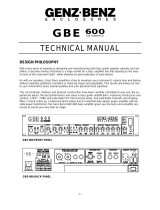 Genz-Benz GBE 600 User manual
Genz-Benz GBE 600 User manual
-
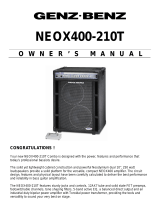 Genz-Benz NEOX400-210T User manual
Genz-Benz NEOX400-210T User manual
-
Genz Benz NEOX400-112T Owner's manual
-
Genz Benz GBE 1200 Technical Manual
-
Genz Benz GBE 750 Technical Manual
-
Genz Benz GBE 400 Technical Manual
-
Genz Benz Shuttle Max 9.2 Owner's manual
-
Genz Benz Shuttle Max 9.2 Owner's manual
-
 Genz-Benz Intro-50 User manual
Genz-Benz Intro-50 User manual
-
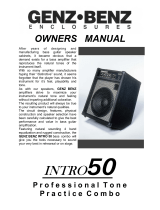 Genz-Benz Intro-50 User manual
Genz-Benz Intro-50 User manual
Other documents
-
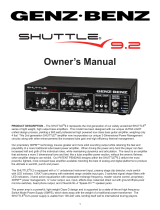 Genz-Benz 9.2 User manual
Genz-Benz 9.2 User manual
-
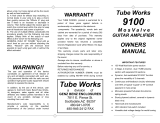 Genz-Benz 9100 MosValve User manual
Genz-Benz 9100 MosValve User manual
-
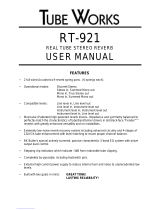 Tube Works RT-921 User manual
Tube Works RT-921 User manual
-
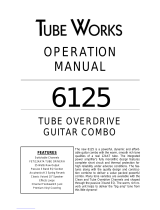 Tube Works 6125 Operating instructions
Tube Works 6125 Operating instructions
-
Ibanez EDA Bass Owner's manual
-
Acoustic B410C Owner's manual
-
Alesis MICROVERB 4 User manual
-
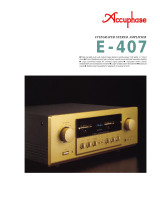 Accuphase E-407 User manual
Accuphase E-407 User manual
-
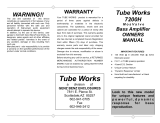 Tube Works 7200H Owner's manual
Tube Works 7200H Owner's manual
-
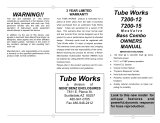 Tube Works MosValve 7200-12 Owner's manual
Tube Works MosValve 7200-12 Owner's manual

















